Treatment stingray sting. Stingray Sting Treatment: Essential First Aid Guide for Marine Injuries
How do you treat a stingray sting. What are the symptoms of a stingray injury. When should you seek medical attention for a stingray sting. What is the most effective pain relief for stingray stings. How can you prevent stingray injuries while swimming or diving. What complications can arise from untreated stingray stings. How long does pain from a stingray sting typically last.
Understanding Stingray Anatomy and Behavior
Stingrays are fascinating marine creatures, known for their flat bodies and distinctive tails. These animals possess one to three barbed venomous spinal blades on their tails, which they use primarily for self-defense against predators like sharks and large carnivorous fish. Contrary to popular belief, stingrays are generally shy and non-aggressive towards humans.
Despite their peaceful nature, stingrays can cause serious injuries when provoked or accidentally stepped on. Understanding their anatomy and behavior is crucial for preventing and treating stingray-related injuries.

Stingray Physical Characteristics
- Flat, disc-shaped bodies
- Long, thin, whip-like tails
- One to three barbed venomous spinal blades on the tail
- Varying sizes, from small to quite large
The Mechanism of Stingray Injuries
Stingray injuries typically occur when an unsuspecting swimmer or wader steps on a stingray buried in the sand. This action provokes the stingray to defend itself by thrusting its tail upward and forward, driving the venomous spine into the person’s foot or leg.
When the spine penetrates the skin, the integumentary sheath surrounding it ruptures, releasing venom into the victim’s tissues. This process results in immediate, severe pain and other symptoms.
Common Scenarios for Stingray Injuries
- Walking in shallow coastal waters
- Wading in bays or backwaters
- Accidentally disturbing buried stingrays while swimming
- Handling stingrays during fishing activities
Symptoms and Clinical Presentation of Stingray Stings
Recognizing the symptoms of a stingray sting is crucial for prompt and effective treatment. The primary symptom is immediate, intense pain at the site of injury. However, several other clinical manifestations may occur.

Primary Symptoms
- Severe, immediate pain at the injury site
- Pain spreading rapidly to surrounding areas
- Peak pain intensity within 90 minutes of the sting
- Pain duration ranging from 6 to 48 hours, occasionally lasting days or weeks
Secondary Symptoms
- Syncope (fainting)
- Weakness
- Nausea
- Anxiety
- Lymphangitis (inflammation of lymphatic vessels)
- Vomiting
- Diarrhea
- Sweating
- Generalized muscle cramps
- Inguinal or axillary pain
- Respiratory distress (in severe cases)
Are all stingray stings equally severe? While most stingray injuries are painful but not life-threatening, the severity can vary depending on the location of the sting and the individual’s reaction to the venom. Stings to the abdomen, chest, or neck are considered more dangerous and require immediate medical attention.
Immediate First Aid for Stingray Stings
Prompt and appropriate first aid is essential for managing stingray injuries effectively. The following steps should be taken immediately after a stingray sting:
- Remove the victim from the water to prevent drowning due to pain or shock.
- Gently irrigate the wound with salt water to remove fragments of spine, glandular tissue, and integument.
- Control bleeding by applying direct pressure to the wound.
- Immerse the affected area in hot water (as hot as the victim can tolerate without burning) for 30-90 minutes. This may help neutralize the venom and provide pain relief.
- If possible, remove any visible fragments of the stingray’s spine, but only if they are superficially embedded.
- Seek medical attention, especially if the sting is on the abdomen, chest, or neck, or if symptoms are severe.
Is hot water immersion always recommended for stingray stings? While hot water immersion is commonly advised and anecdotally reported to provide relief, its effectiveness as an early treatment has not been scientifically verified. However, many experts still recommend it as a first-aid measure due to its potential benefits in pain management.

Medical Treatment and Wound Care
Once the victim reaches a medical facility, healthcare professionals will provide more comprehensive treatment. The approach typically includes:
Wound Examination and Debridement
- Thorough examination of the wound for remnants of the stingray’s sheath
- Careful debridement of the wound
- Administration of local anesthetic as needed
- Removal of embedded spines, treating them as foreign bodies
Systemic Treatment
- Supportive care for systemic manifestations
- Administration of tetanus prophylaxis
- Elevation of the injured extremity for several days
- Possible use of antibiotics to prevent infection
Additional Considerations
- Close evaluation of patients stung on the trunk for potential visceral puncture
- Possible need for surgical wound closure
- Pain management, which may include both local and systemic analgesics
How long does it take for a stingray wound to heal? The healing time for stingray wounds can vary depending on the severity of the injury and the effectiveness of treatment. Minor stings may heal within a few days to a week, while more severe injuries could take several weeks to heal completely.

Potential Complications and Long-Term Effects
While most stingray injuries heal without significant complications, some potential risks and long-term effects should be considered:
Immediate Complications
- Severe allergic reactions to the venom
- Shock due to pain or blood loss
- Infection of the wound
- Tissue necrosis around the sting site
Long-Term Effects
- Chronic pain at the injury site
- Scarring
- Reduced mobility if the sting affects a joint
- Psychological trauma, including fear of water activities
Can stingray venom cause long-term health problems? While rare, there have been reports of individuals experiencing prolonged pain or sensitivity at the sting site. However, most people recover fully without lasting effects when proper treatment is administered promptly.
Prevention Strategies for Stingray Injuries
Preventing stingray injuries is always preferable to treating them. Here are some effective strategies to minimize the risk of stingray encounters:
The “Stingray Shuffle”
When walking in shallow coastal waters, use the “stingray shuffle” – sliding your feet along the sand instead of taking normal steps. This movement alerts stingrays to your presence, giving them time to swim away.

Protective Footwear
Wear thick-soled water shoes or booties when wading in areas known to have stingrays. While not foolproof, this can provide some protection against stings.
Awareness of Environment
- Pay attention to warning signs on beaches about marine life hazards.
- Ask local lifeguards or authorities about stingray presence in the area.
- Be extra cautious during stingray mating seasons when they may be more aggressive.
Safe Handling Practices
For those who fish or work with stingrays:
- Use proper handling techniques, avoiding the tail area.
- Utilize protective gear such as thick gloves and puncture-resistant clothing.
- Consider using tools designed for safely handling stingrays.
Does time of day affect the likelihood of stingray encounters? Stingrays are often more active during dawn and dusk when they feed. However, encounters can occur at any time, so it’s important to remain vigilant whenever in their habitat.
Global Incidence and Geographical Distribution of Stingray Injuries
Stingray injuries occur worldwide in coastal areas, with varying frequency depending on the region. Understanding the global distribution and incidence of these injuries can help in developing targeted prevention and treatment strategies.
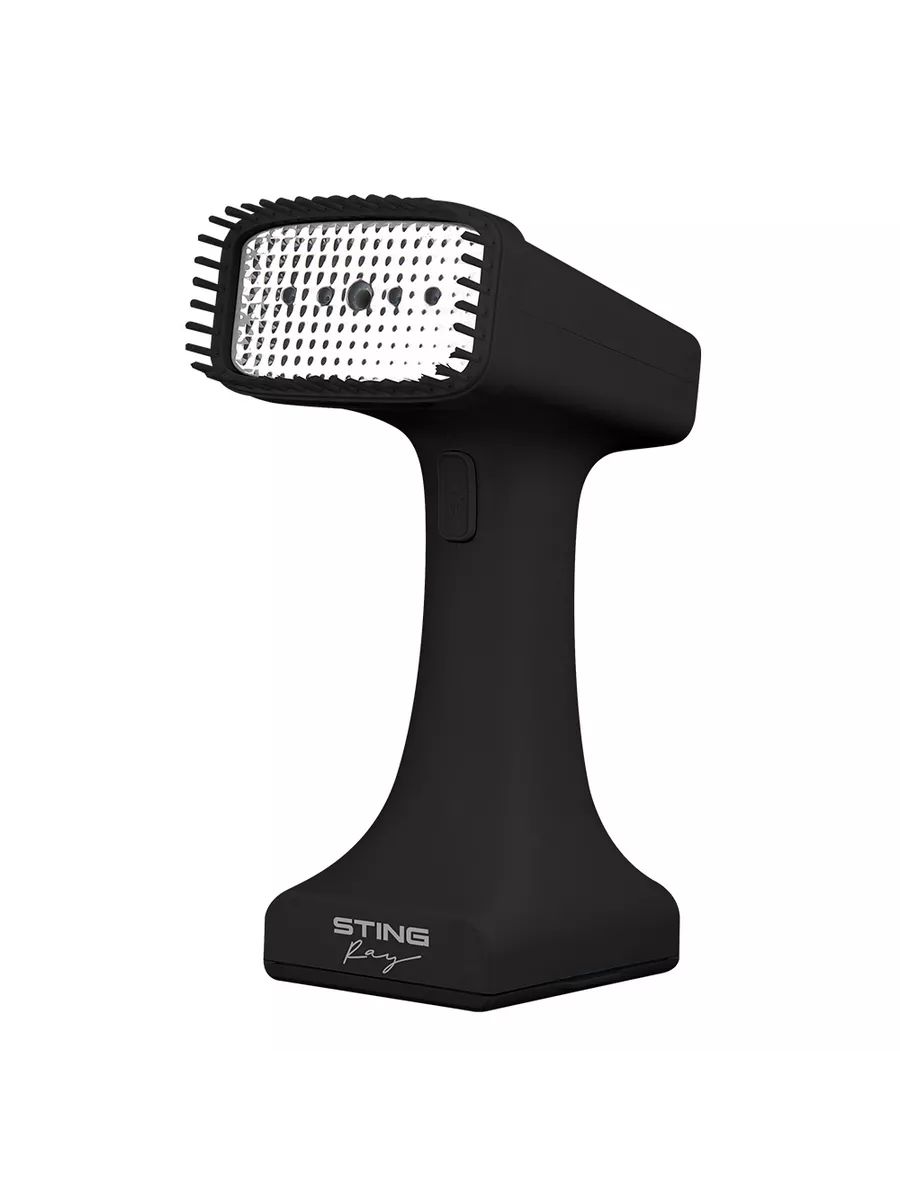
North American Incidence
Historically, North American coasts reported about 750 stingray stings per year. However, current accurate data is limited as many cases go unreported. The United States sees an estimated 1,500-2,000 stingray injuries annually, with higher incidences in coastal states like California and Florida.
Global Hotspots
- Australia: Known for a high number of stingray encounters, particularly along the Great Barrier Reef.
- Southeast Asia: Countries like Thailand and Indonesia report significant numbers of stingray injuries among tourists and locals.
- Caribbean: Popular tourist destinations in this region see regular stingray encounters, some in controlled environments for tourism purposes.
- South America: Coastal areas of Brazil and other South American countries report stingray injuries, especially in river systems.
Factors Influencing Geographical Distribution
- Water temperature: Stingrays prefer warm waters, making tropical and subtropical regions more prone to encounters.
- Coastal topography: Sandy, shallow areas are ideal habitats for many stingray species.
- Human activity: Increased tourism and water-based activities in certain areas can lead to more frequent encounters.
- Local stingray populations: Some regions naturally have higher concentrations of stingrays due to favorable environmental conditions.
Are certain stingray species more dangerous than others? While all stingrays capable of stinging pose a potential threat, larger species like the southern stingray or the short-tail stingray can inflict more severe injuries due to their size and strength. However, the danger often depends more on the location of the sting and the individual’s reaction to the venom rather than the specific species involved.

Research and Advancements in Stingray Sting Treatment
As marine biology and medical science progress, new insights and treatments for stingray injuries continue to emerge. Staying informed about these advancements can lead to improved management of stingray stings.
Venom Research
Scientists are studying stingray venom composition to better understand its effects on human physiology. This research could lead to more targeted treatments and potentially the development of antivenoms specific to stingray toxins.
Pain Management Innovations
New approaches to pain management for stingray stings are being explored, including:
- Topical anesthetics designed for marine envenomations
- Novel systemic pain medications with fewer side effects
- Exploration of natural compounds that may neutralize stingray venom
Wound Healing Techniques
Advancements in wound care could improve healing outcomes for stingray injuries:
- Bioengineered skin substitutes to promote faster healing
- Advanced dressings that may reduce scarring and prevent infection
- Techniques to minimize tissue damage from venom
Prevention Technologies
Innovative approaches to prevent stingray encounters are being developed:

- Acoustic deterrent devices to keep stingrays away from popular swimming areas
- Improved protective gear for divers and marine researchers
- Enhanced detection methods to identify stingray presence in water
How might future technologies change our approach to stingray sting prevention and treatment? Emerging technologies like artificial intelligence and nanotechnology could potentially revolutionize both prevention and treatment. AI might be used to predict stingray movements and warn beachgoers, while nanotechnology could lead to more effective and targeted delivery of pain relief and anti-inflammatory agents directly to the sting site.
As research continues, our understanding of stingray biology and the effects of their venom on humans will undoubtedly improve. This knowledge will likely lead to more effective prevention strategies and treatment protocols, ultimately reducing the impact of stingray injuries on human health and marine recreation.
Stingray Stings – Injuries; Poisoning
By
Robert A. Barish
, MD, MBA, University of Illinois at Chicago;
Thomas Arnold
, MD, Department of Emergency Medicine, LSU Health Sciences Center Shreveport
Reviewed/Revised Jan 2022 | Modified Sep 2022
View Patient Education
Topic Resources
Stingrays once caused about 750 stings/year along North American coasts; the present incidence is unknown, and most cases are not reported. Venom is contained in one or more spines on the dorsum of the animal’s tail. Injuries usually occur when an unwary swimmer wading in ocean surf, bay, or backwater steps on a stingray buried in the sand and provokes it to thrust its tail upward and forward, driving the dorsal spine (or spines) into the patient’s foot or leg. The integumentary sheath surrounding the spine ruptures, and the venom escapes into the patient’s tissues.
The integumentary sheath surrounding the spine ruptures, and the venom escapes into the patient’s tissues.
The main symptom of a stingray sting is immediate severe pain. Although often limited to the injured area, the pain may spread rapidly, reaching its greatest intensity in < 90 minutes; in most cases, pain gradually diminishes over 6 to 48 hours but occasionally lasts days or weeks. Syncope, weakness, nausea, and anxiety are common and may be due, in part, to peripheral vasodilation. Lymphangitis, vomiting, diarrhea, sweating, generalized cramps, inguinal or axillary pain, respiratory distress, and death have been reported.
The wound is usually jagged, bleeds freely, and is often contaminated with parts of the integumentary sheath. The edges of the wound are often discolored, and some localized tissue destruction may occur. Generally, some swelling is present. Open wounds are subject to infection.
Stingray stings to an extremity should be gently irrigated with salt water in an attempt to remove fragments of spine, glandular tissue, and integument. The spine should be removed in the field only if it is superficially embedded and is not penetrating the neck, thorax, or abdomen or creating a through-and-through injury of a limb. Significant bleeding should be staunched with local pressure. Warm water immersion, although recommended by some experts, has not been verified as an effective early treatment for stingray injuries.
The spine should be removed in the field only if it is superficially embedded and is not penetrating the neck, thorax, or abdomen or creating a through-and-through injury of a limb. Significant bleeding should be staunched with local pressure. Warm water immersion, although recommended by some experts, has not been verified as an effective early treatment for stingray injuries.
In the emergency department, the wound should be reexamined for remnants of the sheath and debrided; a local anesthetic may be given as needed. Embedded spines are treated similarly to other foreign bodies. Patients stung on the trunk should be evaluated closely for puncture of viscera. Treatment of systemic manifestations is supportive. Tetanus prophylaxis should be given (see table ), and an injured extremity should be elevated for several days. Use of antibiotics and surgical wound closure may be necessary.
NOTE:
This is the Professional Version.
CONSUMERS:
View Consumer Version
Copyright © 2023 Merck & Co., Inc., Rahway, NJ, USA and its affiliates. All rights reserved.
Test your knowledge
Take a Quiz!
Prevention & Treatment of Stingray Injuries
The Bottom Line
Stingrays have long, thin, whip-like tails equipped with one to three barbed venomous spinal blades. Although they are generally shy, they may strike when unintentionally stepped on. Their venom causes intense pain, but the main risk of a stingray injury is the puncture wound. Hot water immersion and good wound care are central to managing stingray injuries.
Need help?
Get help onlineor
Call 1-800-222-1222
The Full Story
The stingray has a fierce reputation and is best known for its infamous tail – long, thin, and whip-like with one to three barbed venomous spinal blades. In Greek mythology, Odysseus was killed when his son Telegonus unintentionally stabbed him using a spear tipped with the spine of a stingray. In 2006, television personality and animal activist Steve Irwin, best known as The Crocodile Hunter, died after being pierced in his chest by a stingray. Stingrays pose a threat to fishermen and beachgoers. Every year, about 1,500-2,000 stingray injuries are reported in the US.
In Greek mythology, Odysseus was killed when his son Telegonus unintentionally stabbed him using a spear tipped with the spine of a stingray. In 2006, television personality and animal activist Steve Irwin, best known as The Crocodile Hunter, died after being pierced in his chest by a stingray. Stingrays pose a threat to fishermen and beachgoers. Every year, about 1,500-2,000 stingray injuries are reported in the US.
Contrary to its reputation, the stingray is a shy and even gentle creature that would rather swim away than strike. It reserves its stinger for its predators – sharks and other large carnivorous fish. It attacks people only when it feels directly threatened, often when it’s unintentionally stepped on.
Stingrays are flat and can vary in size from several inches to 6.5 ft. in length and weigh up to 800 lbs. Their wing-like fins create ripples in the water as they swim. There are 11 species of stingrays found in the coastal waters of the US. Their flat bodies and gray color allow them to be camouflaged on the sea floor, where they move slowly to forage for their prey (small fish and crustaceans like crabs and sea snails).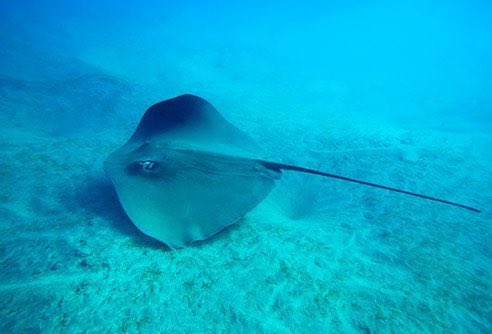 Interestingly, a stingray cannot see its prey because its eyes are on the upper side of its body, while its mouth and nostrils are on the underside.
Interestingly, a stingray cannot see its prey because its eyes are on the upper side of its body, while its mouth and nostrils are on the underside.
The dangerous part of a stingray is its infamous tail. The spinal blade is also known as the stinger or barb. This stinger is covered with rows of sharp spines made of cartilage and is strong enough to pierce through the skin of an attacker. Not only does the puncture itself cause injury and pain, but the stinger also releases a complex venom, which leads to intense pain at the puncture site. Uncommon effects of the venom include headaches, nausea and vomiting, fainting, low blood pressure, arrhythmias of the heart, and even seizures.
The most common sites of human envenomation are the legs and feet, which makes sense because the most common reason for envenomation is a swimmer unintentionally stepping on a stingray. The envenomation is often limited to severe pain that is relieved when the area is submerged in hot water. However, complications such as infection, serious bleeding, or physical trauma can occur.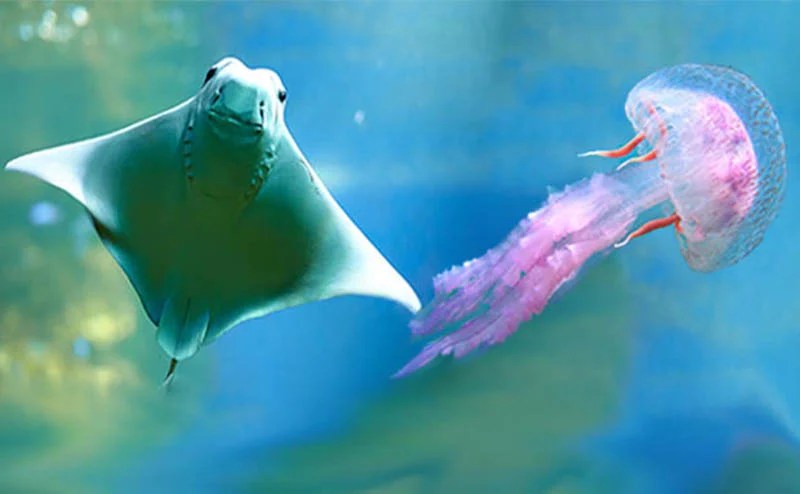 Part of the spine can also remain embedded in the tissue and require medical intervention to remove it. Death is extremely rare and results not from the venom but from the puncture wound itself if it is in the chest, abdomen, or neck. Death from serious infections like tetanus has also been reported.
Part of the spine can also remain embedded in the tissue and require medical intervention to remove it. Death is extremely rare and results not from the venom but from the puncture wound itself if it is in the chest, abdomen, or neck. Death from serious infections like tetanus has also been reported.
Treatment of stingray injuries starts with first aid. Because the puncture is often deep and considered dirty, there is high risk of infection. It’s important to wash and disinfect the area immediately and obtain a tetanus vaccine or booster if needed. The wound should be inspected for any retained spines. The standard treatment for the pain is hot water immersion. Medical evaluation and treatment in a hospital is necessary if there are any retained spines in the wound, if the puncture is deep, or if it involves the chest, abdomen, or neck.
The best way to prevent being stung by a stingray is to avoid stepping on it when in the ocean by shuffling through the sand rather than lifting your feet and walking normally (commonly referred to as the “stingray shuffle”). This will warn a stingray of your approach, and it will likely swim away. A pole or stick can also be used ahead of your feet. Divers should be cautious and avoid swimming close to the sea floor. It is also important to know where stingrays are and never provoke them.
This will warn a stingray of your approach, and it will likely swim away. A pole or stick can also be used ahead of your feet. Divers should be cautious and avoid swimming close to the sea floor. It is also important to know where stingrays are and never provoke them.
If you have a stingray injury, check the webPOISONCONTROL® online tool for guidance or call Poison Control at 1-800-222-1222.
Serkalem Mekonnen, RN, BSN, MPH
Certified Specialist in Poison Information
Poisoned?
Call
1-800-222-1222
or
HELP ME online
Prevention Tips
- To avoid unintentionally stepping on a stingray, shuffle or drag your feet along the sea floor rather than lifting your feet and walking normally (do the “stingray shuffle”).

- Divers should avoid swimming too close to the sea floor.
- Fishermen who unintentionally catch a stingray should not attempt to disentangle it from the net or fishing line.
- Never provoke a stingray.
This Really Happened
A 47-year-old Danish man was stung on his left ankle by a stingray while he was vacationing on the west coast of Africa. He was stung while walking in shallow waters about 10 ft. from the beach. He immediately experienced intense pain in his left ankle, and he limped to shore. A local sailor repeatedly attempted to suck out the venom with his mouth. He also brought an unknown plant root, chewed it, and applied it to the wound with a compression band.
The pain gradually lessened over the course of a few hours. The plant root and compression band were removed. On the fourth day following the injury, the man developed a high fever along with shivering. The wound had become infected. He was started on oral antibiotics, but the wound did not get better – it was red, swollen, and necrotic. He was switched to intravenous antibiotics and was eventually flown back to Denmark for continued medical treatment.
He was switched to intravenous antibiotics and was eventually flown back to Denmark for continued medical treatment.
The wound was surgically cleaned. Samples of the tissue indicated a mixed infection with bacteria usually found in the human mouth. The wound slowly healed, and the man was able to return to work 3 months after the incident. (From Hønge et al.)
Share this:
Facebook
Twitter
Reddit
For More Information
Stauffer K, Wallace RM, Galland GG, Marano N. Animal bites & stings (zoonotic exposures) [Internet]. Atlanta: Centers for Disease Control and Prevention; updated 2019 Jun 24 [cited 2020 Feb 28].
References
Charnigo A, Thiele G, Ondrus R. Stingray sting [Internet]. Treasure Island (FL): StatPearls Publishing; updated 2019 Jun 3 [cited 2020 Feb 28].
Hønge LB, Patsche CB, Jensen MM, et al.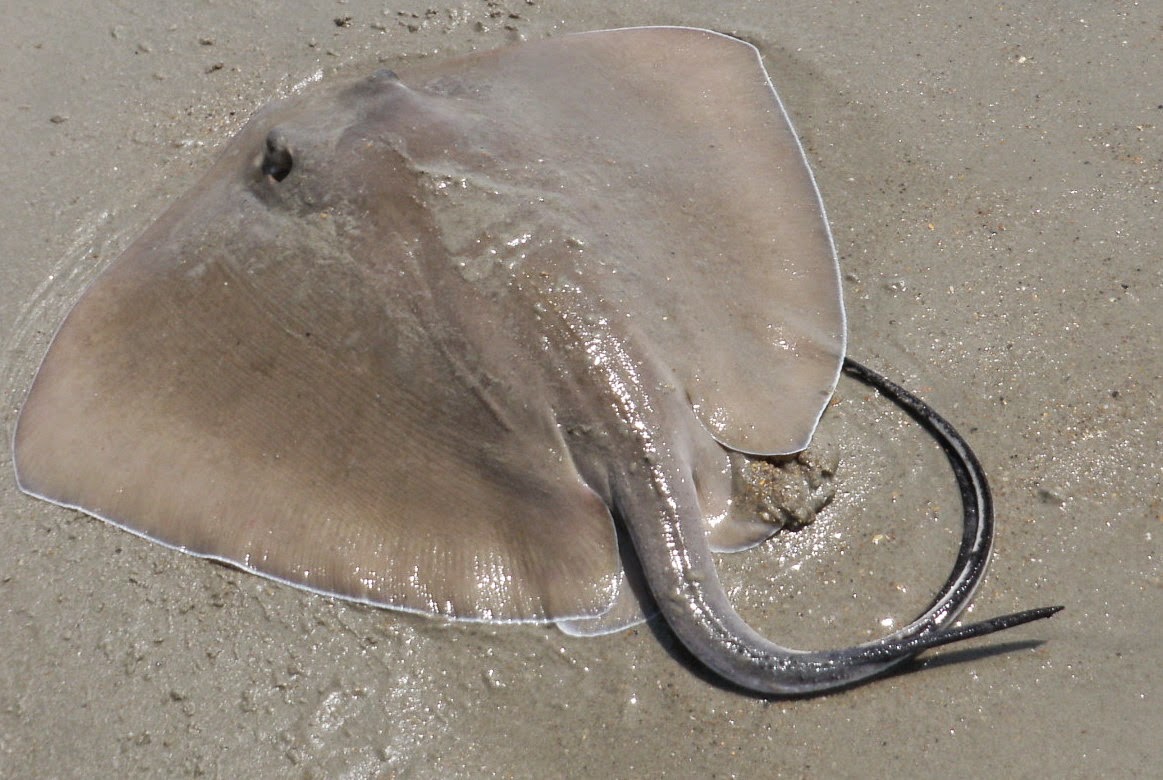 Case report: iatrogenic infection from traditional treatment of stingray envenomation. Am J Trop Med Hyg. 2018 Mar;98(3):929-32
Case report: iatrogenic infection from traditional treatment of stingray envenomation. Am J Trop Med Hyg. 2018 Mar;98(3):929-32
Blohm E; Brush DE. Marine envenomations. In: Nelson LS, Howland MA, Lewin NA, Smith SW, Goldfrank LR, Hoffman RS, editors. Goldfrank’s toxicologic emergencies. New York: McGraw-Hill Education; 2019.
Stingrays [internet]. Washington: National Geographic; 2018 Sep 24 [cited 2020 Feb 28].
Poisoned?
Call
1-800-222-1222
or
HELP ME online
Prevention Tips
- To avoid unintentionally stepping on a stingray, shuffle or drag your feet along the sea floor rather than lifting your feet and walking normally (do the “stingray shuffle”).
- Divers should avoid swimming too close to the sea floor.

- Fishermen who unintentionally catch a stingray should not attempt to disentangle it from the net or fishing line.
- Never provoke a stingray.
This Really Happened
A 47-year-old Danish man was stung on his left ankle by a stingray while he was vacationing on the west coast of Africa. He was stung while walking in shallow waters about 10 ft. from the beach. He immediately experienced intense pain in his left ankle, and he limped to shore. A local sailor repeatedly attempted to suck out the venom with his mouth. He also brought an unknown plant root, chewed it, and applied it to the wound with a compression band.
The pain gradually lessened over the course of a few hours. The plant root and compression band were removed. On the fourth day following the injury, the man developed a high fever along with shivering. The wound had become infected. He was started on oral antibiotics, but the wound did not get better – it was red, swollen, and necrotic.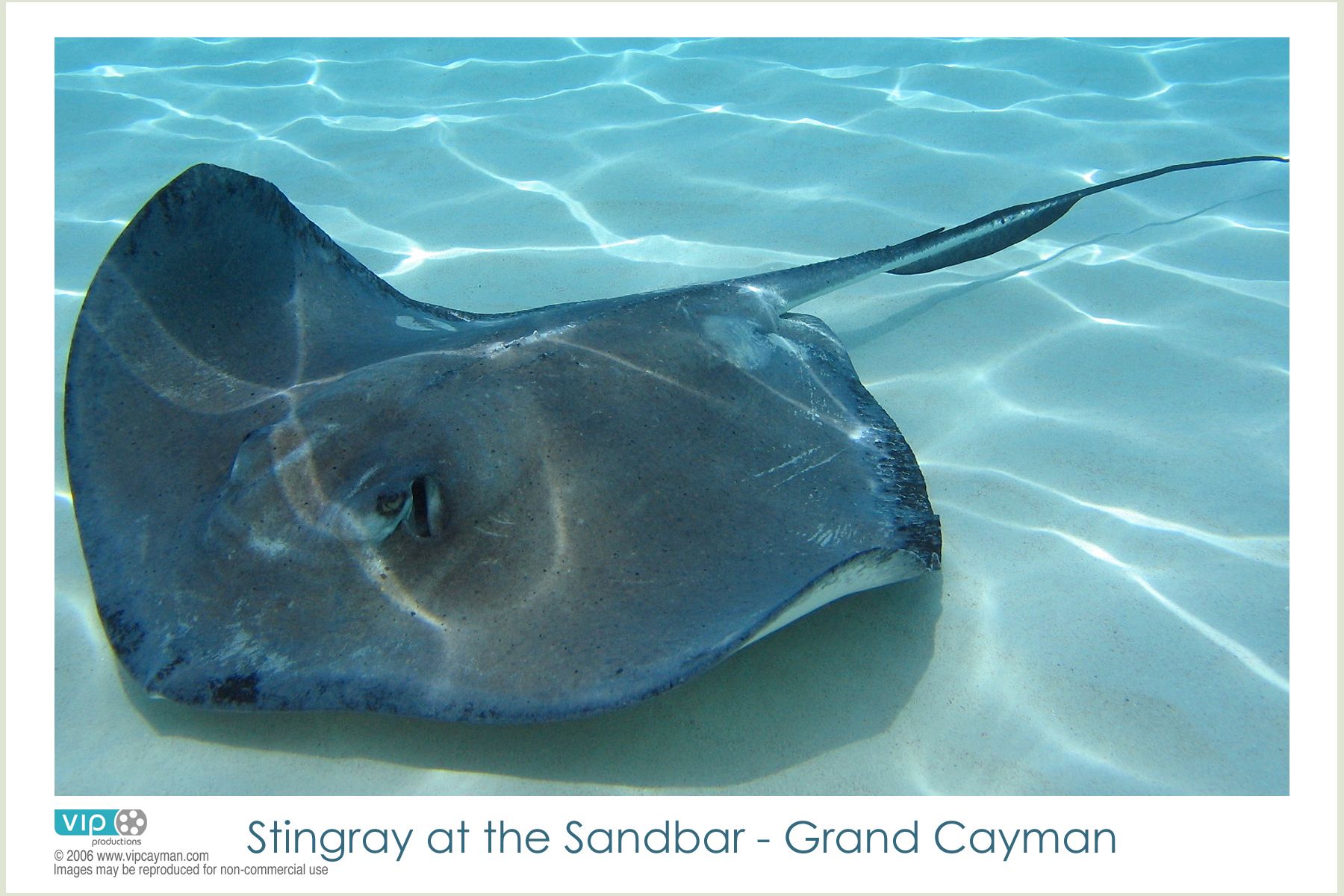 He was switched to intravenous antibiotics and was eventually flown back to Denmark for continued medical treatment.
He was switched to intravenous antibiotics and was eventually flown back to Denmark for continued medical treatment.
The wound was surgically cleaned. Samples of the tissue indicated a mixed infection with bacteria usually found in the human mouth. The wound slowly healed, and the man was able to return to work 3 months after the incident. (From Hønge et al.)
Consequences of being stung by a venomous stingray
Southern stingray spines (Dasyatis americana)
Rays form one of the largest and most important groups of venomous marine animals. 2,000 stingray stings are reported annually in the US. They live in warm, subtropical and tropical waters. The favorite habitat of these passive, secretive animals is the sandy or muddy bottom of closed lagoons and estuaries, where they feed on crustaceans and molluscs.
Rays have one to four venomous stingers on the back of an elongated whip-like appendage. This tail is a cartilaginous process studded with serrated spines. It is covered with a thin layer of skin that hides two ventrolateral areas with venom glands. When the tail plunges into the prey, the epithelial lining of the glands ruptures, releasing the venom. Like other venomous fish, the shell breaks on contact with prey, allowing the venom to enter the wound. The venom contains at least 10 amino acids and toxic substances, including phosphodiesterases, 5′-nucleotidase and serotonin. When extracted, the poison is very quickly destroyed, as it is very unstable and thermolabile.
It is covered with a thin layer of skin that hides two ventrolateral areas with venom glands. When the tail plunges into the prey, the epithelial lining of the glands ruptures, releasing the venom. Like other venomous fish, the shell breaks on contact with prey, allowing the venom to enter the wound. The venom contains at least 10 amino acids and toxic substances, including phosphodiesterases, 5′-nucleotidase and serotonin. When extracted, the poison is very quickly destroyed, as it is very unstable and thermolabile.
Rays only attack defensively, and this usually happens when humans inadvertently touch or step on an animal. If you touch the wings of a stingray, then it throws its tail forward, plunging it into the victim. Out of the water, a stingray can also prick a person while in a net or on a hook. There has been a documented case of injury by a person stepping on a dead, decaying animal.
Rays occasionally appear on the coast of Wales. Below is a case of a fisherman getting a lacerated wound on his lower leg from contact with a stingray.
Case description
Stingrays appeared on the coast of Wales in July 1994. An angler caught a 19 kilogram (42 lb) stingray in south Wales but was able to avoid contact with the venomous stinger. On the west coast of Wales, a fisherman caught an 18-kilogram (40 lb) stingray during a fishing event run by the Welsh Fire Department. Several colleagues helped him get the animal to shore, and, unfortunately, one of them hit the stingray, which stuck its tail into the fisherman. The sting penetrated boots (modified rubber) and trousers, tearing the shin of the left leg. The patient reported acute pain in the area of the wound. Later the pain spread to the ankle. The fisherman went to the nearest emergency room. The doctor who examined him reported the incident to the Welsh National Poisons Unit, who gave advice on how to treat the injury. The wound was washed with warm water to neutralize thermolabile poisons. Then it was disinfected, and the edges of the wound were treated surgically under general anesthesia. The wound was not sutured, but bandaged, and the patient was left overnight for further observation. The patient was prescribed antibiotics, tetanus toxoid vaccine was not required. The angler was discharged the next morning and was seen by his therapist. Follow-up showed that the patient went to the emergency room again because the leg was swollen and red. The soft tissues of the leg were examined several times, and the wound healed in two months. There was an 8 cm scar on the lower leg.
The wound was not sutured, but bandaged, and the patient was left overnight for further observation. The patient was prescribed antibiotics, tetanus toxoid vaccine was not required. The angler was discharged the next morning and was seen by his therapist. Follow-up showed that the patient went to the emergency room again because the leg was swollen and red. The soft tissues of the leg were examined several times, and the wound healed in two months. There was an 8 cm scar on the lower leg.
Discussion
Clinical manifestation
The symptoms of the injection appear immediately. Severe pain appears in the area of the wound, proportional to the severity of the injury. Swelling around the wound is constant, but its severity may vary. The wound turns blue, then erythema (violent reddening of the skin caused by capillary dilation) and petechiae (tiny hemorrhages) may appear. As a result, local tissue necrosis, ulceration, gangrene may occur. Pain peaks within 90 minutes. Without medical treatment of the wound, the pain lasts up to 48 hours. Systemic manifestations and signs can vary greatly and include nausea and vomiting, muscle cramps and fasciculations, sweating, fainting, and headaches. Cardiac arrhythmias, hypotension, convulsions and, in rare cases, death have also been reported.
Without medical treatment of the wound, the pain lasts up to 48 hours. Systemic manifestations and signs can vary greatly and include nausea and vomiting, muscle cramps and fasciculations, sweating, fainting, and headaches. Cardiac arrhythmias, hypotension, convulsions and, in rare cases, death have also been reported.
Soft tissue injury from a stingray sting can be quite extensive. In addition to the stab wound, the cutting action of the spikes leads to damage and rupture of the underlying soft tissues. Most often, people injure the lower and upper limbs. Serious injuries and deaths from stings from rays are described in Cooper’s article, including fatal cases from tail strikes to the chest and abdomen. Foreign components (cartilage and epithelium) can get into the wound. Secondary infection is quite common due to the unique environment created by seawater. Pathogenic marine bacteria can be halophilic (bacteria that live in environments with high salt concentrations), heterotrophic (bacteria that need complex compounds for nutrition, since the possibilities for their synthesis are limited), motile, gram-negative. The genus of bacteria Vibrio (Vibrio) is quite common and can be very dangerous for people with weakened immune systems.
The genus of bacteria Vibrio (Vibrio) is quite common and can be very dangerous for people with weakened immune systems.
Treatment
The goal of treatment is to neutralize the local and systemic effects of the poison, reduce pain and prevent infection. The wound should be treated immediately with any available liquid. In practice, as a rule, this is sea water. Any noticeable pieces of stinger or epithelial tissue should be removed. As soon as possible, the wound should be washed with warm water (about 40 ° C) for 30-90 minutes, avoiding possible thermal damage. Heat will inactivate any thermolabile poisons. If the pain persists, it can be relieved by lavage with warm water, regional anesthesia, or wound infiltration. Vesicular fluid should be removed in a timely manner under sterile conditions. Then the wound is washed again, examined, necrotic tissues and foreign bodies are removed. With the help of X-rays, the remains of radiopaque cartilage spikes can be determined. It may be necessary to leave the wound open for a while or perform additional surgery. The prophylactic use of antibiotics is controversial, but they can be given to people who are immunosuppressed or have very serious wounds. Always remember to prevent tetanus. Patients should be observed within four hours after the injection for possible systemic reactions. Sometimes the ingestion of poison is accompanied by an allergic reaction, in which case prompt treatment of anaphylaxis is required.
It may be necessary to leave the wound open for a while or perform additional surgery. The prophylactic use of antibiotics is controversial, but they can be given to people who are immunosuppressed or have very serious wounds. Always remember to prevent tetanus. Patients should be observed within four hours after the injection for possible systemic reactions. Sometimes the ingestion of poison is accompanied by an allergic reaction, in which case prompt treatment of anaphylaxis is required.
Fortunately, a large number of stingrays lose or tear the epithelial lining of glands (45% of 4000 in one study), so stingray attacks are limited to soft tissue injury without venom.
——
from: RJ Evans, R S Davies. Stingray injury. Accid EmergMed 1996;13:224-225
Hidden text is here. You must register to view it. |
What to do if you get bitten by a stingray
Contents
- How to avoid contact with a stingray
- What are the consequences of a stingray
- What not to do if a stingray is stung
- What can be done if a stingray is stung
- Interesting facts about Stingrays
Stingrays Stingrays are a family of cartilaginous fish that belongs to the order of stingrays.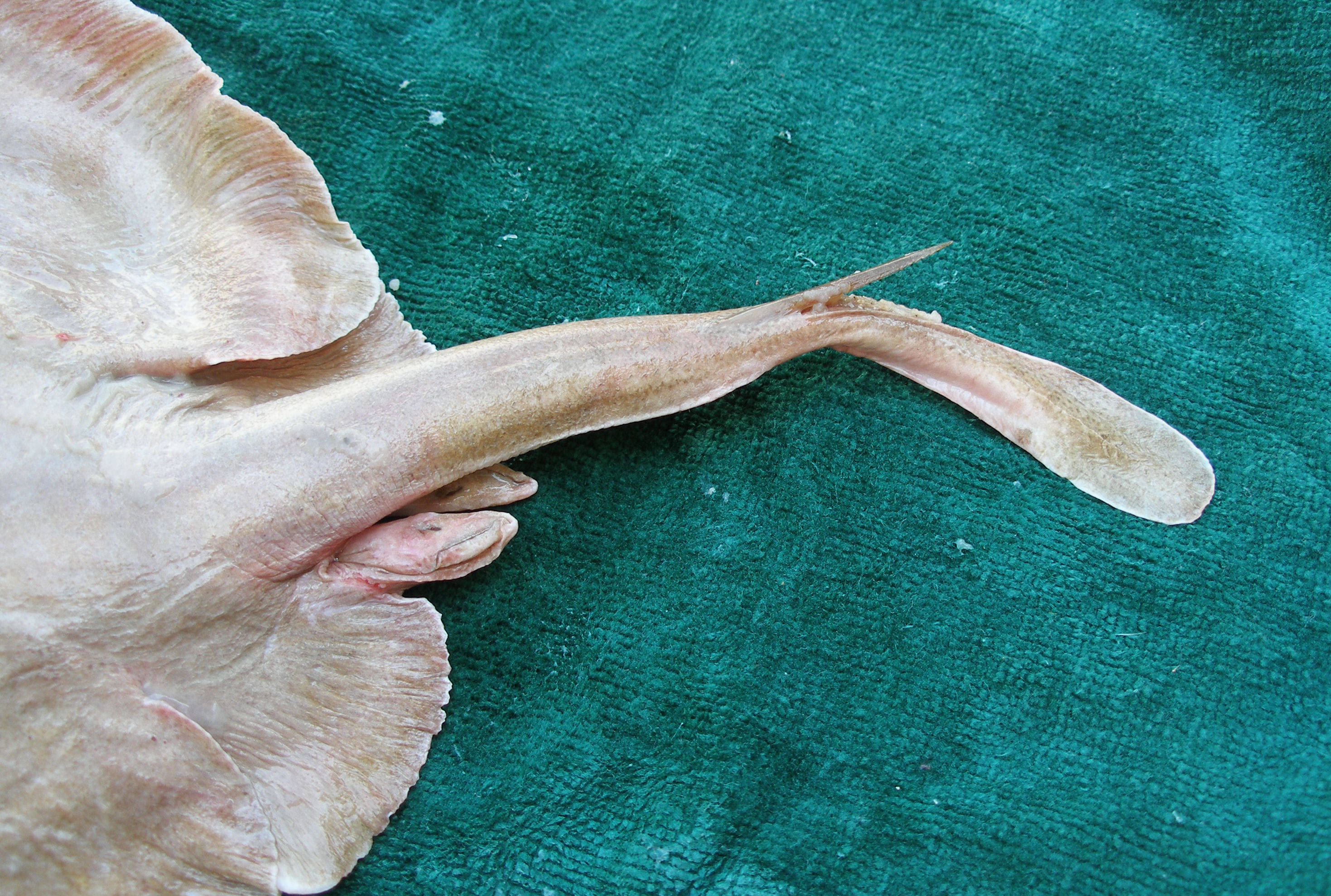 They live in almost all seas and oceans. They feel great in a very wide temperature range, ranging from 1.5 ° C to 30 ° C. Some species are common in shallow water, others are found at depths up to 2500 meters. There are even stingrays that prefer to live in fresh water.
They live in almost all seas and oceans. They feel great in a very wide temperature range, ranging from 1.5 ° C to 30 ° C. Some species are common in shallow water, others are found at depths up to 2500 meters. There are even stingrays that prefer to live in fresh water.
Stingray
Stingrays have a well-defined tail, which looks like a whip. Its length in some species exceeds half the total length of the fish. The tail ends with one or two serrated spikes, along which furrows with poisonous glands often run. The length of the spike can reach up to 37 cm. Thanks to the powerful muscles of the tail and the exceptionally hard spikes, the stingray can easily pierce a wetsuit, a leg, and the bottom of a wooden boat.
It is noteworthy that the stingray uses its tail exclusively for self-defense, since its more than modest teeth are completely unable to cope with such protective functions. When danger arises, the stingray stingray makes sharp lunges up and forward with its tail, and the spike pierces the enemy.
How to avoid contact with the stingray
Stingray spike tip
First, in areas where stingrays spread, enter the water gradually, do not sneak, scuff along the bottom with your feet to scare off the hunter, who might burrow into the sand waiting for a suitable lunch. Be especially careful in shallow bays, river mouths, near beaches, that is, in places that stingrays choose for themselves to hunt.
Secondly, swim in special shoes.
Third, do not enter the water at night.
Fourth, be vigilant while diving, do not tease or pester stingrays.
Fifth, when you find a stingray, make some noise, wave your leg several times under water, try to scare it away.
Sixth, carefully butcher the carcass of the stingray when using it for culinary purposes. The poison of even a dead stingray continues to pose a danger to humans.
What are the consequences of a stingray
Stingray venom has a neurotropic effect, causes instant burning and throbbing pain in the damaged area, the peak of which is observed after 1-1. 5 hours. Painful sensations can persist for several days, gradually fading over the next 6-48 hours. They are so pronounced that the victims begin to scream, rush about. In such cases, even loss of consciousness is possible.
5 hours. Painful sensations can persist for several days, gradually fading over the next 6-48 hours. They are so pronounced that the victims begin to scream, rush about. In such cases, even loss of consciousness is possible.
Contact with a stingray, in addition to pain, is also accompanied by the following symptoms:
- pallor and subsequent redness or blueness of the skin around the wound,
- nausea,
- dizziness,
- chills,
- drop in blood pressure,
- sudden increase in heart rate,
- the appearance of a feeling of anxiety.
Skate in the water
Less commonly, swollen lymph nodes, increased sweating, soreness in the groin and armpits, vomiting and diarrhea. In severe cases, there is a high probability of convulsions, respiratory failure, the victim may become delirious, lose consciousness.
The greatest danger is represented by large individuals, which have a large amount of poison and a powerful thorn. The lethal outcome is observed mainly when injured in the chest or abdomen.
The lethal outcome is observed mainly when injured in the chest or abdomen.
Plus, the stingray’s barb usually causes a laceration that bleeds profusely. Fragments of its coating can remain in the wound, thereby increasing the risk of infection. In this case, the color of the edges of the wound often changes, tissues are destroyed, and pronounced edema appears.
What not to do when stinging a stingray
Under no circumstances should you jerk out fragments of a spike stuck in a wound. If removed incorrectly, the teeth on the spike can cause additional injury to the victim.
Do not cut the wounds either. Such actions do not ensure the removal of poison, but only unnecessarily injure the victim.
It is not recommended to cauterize the damaged area, as this is fraught with the same unfortunate consequences that were discussed in the previous paragraphs.
Do not inject a solution of potassium permanganate or any other strong oxidizers into the wound.
It is forbidden to drink alcoholic beverages, which only aggravate the situation, accelerating the spread and absorption of the poison.
What measures can be taken in case of a stingray
While waiting for a doctor or on the way to the nearest medical facility, the victim can and should be given first aid.
1. First of all, suck out the poison from small puncture wounds for the first 10 minutes after the injection, spitting it out periodically. This can be done only in the absence of any damage in the oral cavity of the sucker. At the end of the procedure, the mouth must be rinsed with a solution of potassium permanganate or simply clean water.
2. To reduce the concentration of poison and relieve pain, the wound should also be washed with sea water in large quantities.
3. Then carefully remove the remaining pieces of the stud that point backwards. In this case, they should be fed a little forward and slightly rotated to unhook the prong from the fabric, and only then removed.
4. Hot baths are recommended. First, you should apply a pressure bandage above the wound and lower the pricked limb for 30-60 minutes in hot water, the temperature of which is slightly below the burn threshold. 3% magnesium sulfate can be added to the water. Every 10 minutes, the pressure bandage should be loosened and tightened again.
5. Finally, apply an antiseptic dressing and immobilize the limb.
Interesting Stingray Facts
- On the coast of North America, about 750 people suffer from stingrays every year.
- Death is recorded in 1% of cases of contact with stingrays.
- Contact with a stingray was fatal to popular Australian naturalist and broadcaster Steve Irwin.
- Indians, Malays, Aborigines of Australia and the inhabitants of the islands of the Pacific and Indian Oceans used stingray spikes as tips for their spears and arrows. And since a stingray can grow a new thorn several times in its life, the natives even cultivated stingrays.


/GettyImages-1235399542-592cf7455f9b5859500a86e3.jpg)

